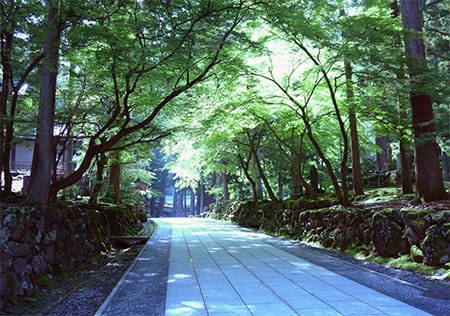



吉祥山永平寺、伽藍建築群空間の探訪ですがまずは背景の把握。
写真は参拝入口、参道、全体配置図。
開山の時代は1192年の鎌倉での武家政権成立からほどない歴史時点。
開祖の道元は1200年生まれ。父親は村上源氏名門・久我家一門という説もある。
久我家は「源氏の長者」を足利家やのちの徳川家と同格で争奪する
公家方の源氏の最有力家系として永く存続し続けてきたようです。が、
この時代こうした家格が成立していたとは言い難く、その縁者ではあっても
「幼時に父母を亡くした」少年道元には仏門で身を立てるしかなかったと思える。
父母の早世が無常感をかれに植え付け仏門を強く願ったのかも知れない。
ただしその後、久我家は大いに家運が上昇しているので、
道元自身の宗教上での「成功」が大いに力になった蓋然性も高い。
公家の家格権威を競う争闘、武家の戦争による争闘と同様に宗教界での論争も
日本的な「家・一門」同士の争闘の大きな要素だったかとも思える。
日本的社会システムとしてこうした上昇志向の「道」があったということか。
道元は14才で最高学府・比叡山延暦寺に上って仏門に入った。
父母を亡くした人物がこういう「サブコース」でも歩めたことを考えると
かれをバックアップする一門の人脈が容易に想像できる。
しかし天台の教えでは人は皆生まれながらにして本来悟っている、
仏性を持っているはずなのに、なぜ厳しい修行をしなければ悟りが得られないのか
という強い疑問をかれは持っていた。いわば最高権威の天台の教えに疑問を持ち、
臨済宗開祖の栄西の開いた建仁寺に17才で入り栄西直弟子の明全に師事したが
それでも疑問は解決せず、師である明全とともに1223年に宋に渡った。
そこから4年、師匠の天童山景徳寺の如浄に入門しやがて法を嗣ぐことを許される。
ひたすら坐禅に打ち込む「只管打坐」に強く影響を受けた。帰国は27才。
京都で興聖寺を建立し説法と著述に励むが、旧仏教勢力からの激しい迫害に遭う。
こうした状況の中で越前を基盤とする武家・波多野氏から後援を申し出られる。
波多野氏は現・神奈川県秦野(はだの・はたの)〜足柄平野地域を基盤とした。
鎌倉幕府草創期には一時平家方に与したが、やがて幕府中枢に勢力を確保する。
1221年承久の乱に際して波多野一族は全国に領地を得て勢力が膨張。
なかでも越前波多野家は中世を通して一族でも傑出した活動を示している。
当時当主は波多野義重であり京都での政治中心・六波羅探題評定衆を勤めている。
評定衆とは主に「西国成敗」任務で訴訟裁判や六波羅の政務を担当する幕府重職。
とくに承久の乱の鎮圧後の六波羅探題は幕府武権最高の地位とも言える。
この人物が道元に対して、越前の地での禅宗道場の開山を申し出たのだ。
時系列では道元の足取りは承久の乱前後の武家と朝廷の緊張関係が背景にある。
政治危機・承久の乱の直後に宋に渡り、帰国後も布教活動に大いに活躍する。
当時の京都で鎌倉幕府中枢にいる波多野氏とどういう接点があったか、
道元帰国後の活動、旧仏教側からの迫害とそれへの鎌倉側からの支援。
武家政権側の仏教各派への政治的態度が象徴的に表れているように思われる。
旧体制・比叡山などに対して批判的で、新仏教「禅宗」支援的な底意を感じる。
そうすることで仏教界を支配する政治目的が存在したと考える方が自然。
そしてその「意思」は鎌倉幕府総体のものであった可能性が高い。
頼朝家系の源氏は嫡流が途絶えた(実朝暗殺1219年2月13日)が、
その後足利氏がもっとも嫡流に近いとされ期待と怖れを幕府内で
集め続けたことも併せ考えると、公家とはいえ源氏の氏族への保護は
波多野家・幕府として政治的に意味が大きかっただろう。
こうした背景から道元は永平寺開山の機縁を得たように思われる。
English version⬇
[Founder / Dogen and supporter " Hatano"Clan Eiheiji-2]
It is a tour of the auspicious mountain Eiheiji Temple and the space of the cathedral architecture, but first of all, grasp the background.
The photo shows the entrance to the worship, the approach to the shrine, and the overall layout.
The era of Kaisan is a historical point shortly after the establishment of the samurai government in Kamakura in 1192.
The founder Dogen was born in 1200. There is also a theory that his father is Murakami Genji's prestigious Koga family.
The Koga family contends for the "Genji no Chōja" with the same rank as the Ashikaga family and later Tokugawa family.
It seems that it has continued to exist for a long time as the most influential family of the Genji of the Kuge. but,
It is hard to say that such a family was established at this time, even if it was a relative.
It seems that Dogen, a boy who "lost his parents when he was young," had no choice but to stand up at the Buddhist gate.
It is possible that his parents' early life planted a sense of impermanence in him and strongly wished for a Buddhist gate.
However, since then, the Kuga family's luck has risen significantly, so
It is highly probable that Dogen's own religious "success" was a great help.
The struggle for the authority of the official family, the struggle in the religious world as well as the struggle due to the war of the samurai
It seems that it was a big element of the struggle between Japanese "houses and families".
Does that mean that there was such an ascending "road" as a Japanese social system?
At the age of 14, Dogen went up to the highest school, Enryakuji Temple on Mt. Hiei, and entered the Buddhist gate.
Considering that the person who lost his parents could walk in such a "sub-course"
It's easy to imagine a family of contacts backing him up.
However, according to the teachings of Tendai, everyone is naturally aware of it.
Why can't I get enlightenment without strict training even though I should have Buddha-nature?
He had a strong question. He questioned the teachings of the highest authority, Tendai, so to speak.
He entered Kenninji Temple, which was opened by Eisai, the founder of the Rinzai sect, at the age of 17, and studied under Eisai's disciple Myozen.
Still, the question was not resolved, and he went to Song in 1223 with his teacher, Myozen.
Four years after that, he was allowed to enter the Rujing of his master, Tendoyama Keitokuji, and eventually to practice the law.
He was strongly influenced by the "Shikantaza", which he devotes himself to zazen. He is 27 years old when he returns to Japan.
He built Kosho-ji Temple in Kyoto and worked hard on his preaching and writing, but he was severely persecuted by the former Buddhist forces.
Under these circumstances, he is offered support by Mr. Hatano, a samurai based in Echizen.
Mr. Hatano is based in the current Hadano-Ashigara Plain area, Kanagawa Prefecture.
In the early days of the Kamakura Shogunate, it was temporarily given to the Heike clan, but eventually it secured its power in the center of the Shogunate.
In 1221, the Hatano clan gained territory all over the country and expanded its power during the Jokyu War.
Among them, the Echizen Hatano family has shown outstanding activities even in the clan throughout the Middle Ages.
At that time, the owner was Yoshishige Hatano, who was the political center of Kyoto, Rokuhara Tandai.
Hyōjōshu is a shogunate executive who is mainly in charge of litigation trials and Rokuhara's affairs in the mission of "Saigoku success or failure".
In particular, the Rokuhara Tandai after the suppression of the Jokyu War can be said to be the highest position of the shogunate martial arts.
This person offered to Dogen to open a Zen Buddhist dojo in Echizen.
In chronological order, Dogen's footsteps are due to the tension between the samurai family and the imperial court before and after the Jokyu War.
Immediately after the political crisis and the Jokyu War, he went to Song and continued to play an active role in missionary work even after returning to Japan.
What kind of contact did you have with Mr. Hatano, who was at the center of the Kamakura Shogunate in Kyoto at that time?
Activities after returning to Dogen, persecution from the former Buddhist side and support from the Kamakura side.
The political attitude of the samurai government toward Buddhist factions seems to be symbolic.
He is critical of the old system, Mt. Hiei, and feels supportive of the new Buddhist "Zen Buddhism."
By doing so, it is more natural to think that there was a political purpose that governed the Buddhist world.
And it is highly possible that the "will" belonged to the Kamakura Shogunate as a whole.
Genji of the Yoritomo family lost his pedigree (Assassination in the morning on February 13, 1219), but
After that, Mr. Ashikaga is said to be the closest to the current, and expectations and fears are raised in the shogunate.
Considering that we continued to collect, even though it is a public house, the protection of Genji's clan is
It seems that the Hatano family and the shogunate had great political significance.
Against this background, Dogen seems to have gained the opportunity to open Mt. Eiheiji.



















